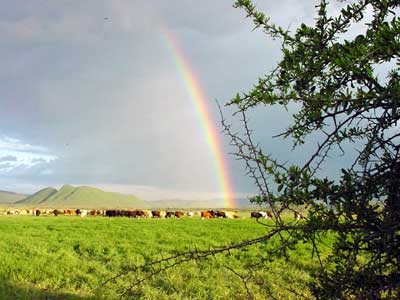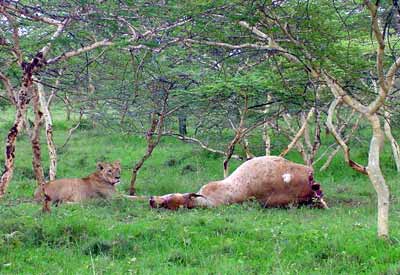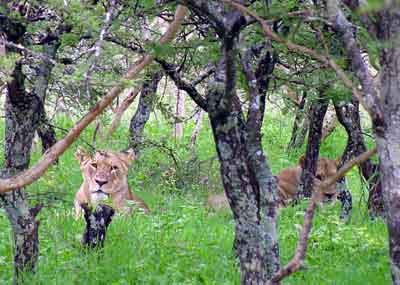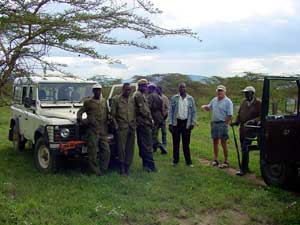|
Eventually, I understood from his rapid Swahili that some lions had killed cattle at the other end of the ranch and knowing my interest in wildlife and big cats, he thought I would be interested in getting out there. He said he had been there earlier on his bicycle repairing a cattle trough but when he heard there were lions around, had ridden "very fast" back to base.This ranch covers 58,000 acres and holds 9,000 cattle. Its' western boundary adjoins Nakuru National Park where there are numerous lions and leopards |
 |
|
The park is surrounded by a 10ft-high electrified fence which separates it from heavily populated areas on most sides. The long rains have set in so it is possible for the big predators to break out in two ways: first, with the ground softened by the rain, warthogs burrow beneath the wire thus providing an exit for other animals or second, a flash flood might weaken the fence or even wash part of it away. |
|
 |
Quickly, I dropped brushes and palette and yelled at Kat to grab cameras and binos. We have just acquired a 10 week-old black lab puppy so little Kivuli (shadow in Swahili) was grabbed too and we set off in the old Land Rover to find the lions. Splashing through the mud, six miles further on we found Nyabola, head of security on the ranch. He pointed us to where the lions were and we soon saw the carcass of a cow with a lioness lying next to it. |
| Surrounding her were a hundred or more vultures and marabou storks plus several jackals all patiently waiting for her to give up her prey. 300 yards away, we found two more lionesses one of which was an enormous beast, probably the mother of the other two mature females.Evidently, they had escaped the park the previous evening and spent the night creating mayhem, killing two cows and six calves. Two rangers from Kenya Wildlife Service were with Nyabola and they told us that they were awaiting instructions from the KWS Warden. They thought maybe a helicopter might come from Nairobi with tranquilizing equipment |
| We were on a track beside a fence and the lioness guarding the carcass was the other side about 100 yards away. A man rode up on a bicycle. I asked him if he was afraid. He looked non-plussed and replied, "Afraid of what?" I pointed out that he was riding through a pride of lions and one was plainly visible. He was shocked and astonished and asked what he should do. I told him to ride very fast which he did as if the devil himself was on his heels. |  |
| As we watched, I noticed a cow and calf moving directly towards the lion. Quickly we drove back up the fence until we found the gate through and then raced back down to where drama was about to happen. The lioness had risen and was crouched, staring intently at the cow from a distance of about 50 yards. We were in acacia thorn scrub but I managed to manoeuvre the vehicle between cow and lion.The lioness had lowered her head and started her stalk. I jumped from the car and ran towards her waving my arms and shouting. She stopped and her tail started to thrash back and forth. This is a serious danger signal and I glanced back to make sure that I had time to reach the car in case she charged. There were two men in the car with me and both had jumped out to try and drive the stupid cow away from its' impending fate. After glaring at us angrily for a few seconds, the lioness growled loudly and retreated a few yards. The tension was broken and we were able to drive cow and calf to relative safety. Kat thinks I am crazy. |
 |
When we returned to the other vehicle, our two men started relating the episode which became more and more embellished with each telling. They had never faced an angry lion on foot even though it had been a relatively safe distance away. I was given hero status for having saved the cow and calf whilst they ragged each other unmercifully for running after the cow with their heads turned backwards to watch for charging lion. We waited two hours but by dusk the authorities had not turned up. The farm guards were speculating on a night which might be filled with drama and were making plans to corral all the cattle in the vicinity and surround them with big fires. We had to leave for home. |
|
That was Friday. The next day, we drove to Nairobi to see my mother and do some shopping. When we returned that evening, I tried to ascertain what had happened. Evidently, the lions had killed more cattle during the night and had caused major panic amongst the farm guards and herdsmen. As dawn broke, they saw that another three big cats had joined the original group including a large male. Throughout the day, the wildlife authorities had tried to drive the lions back towards the park but the one which I had yelled at was proving extremely intransigent and becoming increasingly dangerous. The decision was made to shoot her. After that, the remaining five lions were persuaded to return to the park. As I suspected, a warthog had burrowed under the fence and the lions had used its' tunnel to escape. KWS rangers opened a gap in the fence and the errant cats returned to their proper home. There is an unfortunate postscript to this story. The big lioness came back a day later. She brought with her the younger female which was probably her daughter. In all liklehood, the one that was shot was its'sibling. The pair killed two more calves and all attempts to drive them back through the fence failed. They too were shot. Why did they return? Probably because they had experienced how easy it was to kill cattle and how good prime beef tasted. Maybe because the big female came looking for her missing daughter. If you talk to old timers with much experience of this kind of thing, they will say that once lions have acquired the taste for beef, they will keep coming back so the answer was either to translocate them or, the more drastic option, shoot them. Why were they not tranquilized and taken to another park? KWS have only limited equipment, manpower and funds to cope with such situations. I imagine they have a difficult time allocating priorities. Lions are not exactly endangered. The loss of three will not make a significant impact on the overall population. Wherever wild animals are separated from farms, livestock, crops and people by a fence, no matter how well-constructed and supposedly impenetrable, inevitably tragedies like this will sometimes occur. The big predators, especially, are very territorial and as their numbers increase so too does their need for more space. A nearby farm with a good population of prey animals which don't even run fast is too much of a temptation no matter how formidable the obstacle in between. |
